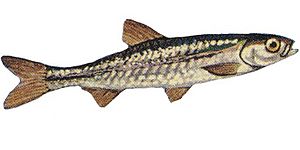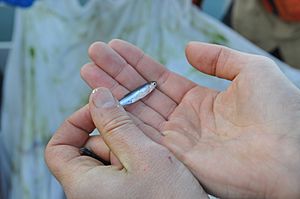Emerald shiner facts for kids
Quick facts for kids Emerald shiner |
|
|---|---|
 |
|
| Conservation status | |
| Scientific classification | |
| Synonyms | |
The emerald shiner (Notropis atherinoides) is a small, shiny, silver fish. It's one of many fish species called shiners. You can tell it apart by the cool silvery-emerald color on its sides.
This fish can grow up to about 3.5 inches long. You can find emerald shiners all over North America, from Canada down to the Gulf of Mexico. They usually live in big, deep lakes and rivers, but sometimes they are found in smaller waters too.
Emerald shiners eat tiny living things like zooplankton and insects. They often gather in large groups near the water's surface. Because they are so common, people often use them as bait fish for fishing.
Contents
Where Emerald Shiners Live
Emerald shiners are originally from North America. They are found widely across Canada and south into states like Virginia and Texas. They also live along the Gulf Coast, from Texas to Alabama. These fish are especially common in the Mississippi Basin. In fact, the emerald shiner is probably the most common fish in the Mississippi River.
What Emerald Shiners Look Like
Size
Emerald shiners can grow to be about 3.5 to 5 inches long. Female emerald shiners are usually a bit bigger than the males.
Colors
When they are alive, emerald shiners are a bright, shiny, silvery-green color. They have a silver stripe along their middle side. Their back and upper sides are emerald green or straw-colored. The bottom part of their body is silvery-white.
Their dorsal (top), caudal (tail), and the front parts of their pectoral (side) fins have dark edges. But the rest of their fin parts are clear. They don't show any special colors during mating season.
Body Shape
Emerald shiners have a thin, flat body shape. Their top fin is clear and has 8 rays. It's located right behind their pelvic (bottom) fins. They have a large mouth that points slightly upwards. They don't have barbels, which are whisker-like feelers.
Where Emerald Shiners Prefer to Live
Emerald shiners live in fresh water. They are found in large, open rivers, lakes, and reservoirs. They like water temperatures around 77°F (25°C). They can also handle low oxygen levels in the water.
These fish usually swim in large or medium-sized groups in the middle or near the surface of the water. Some shiners can handle cloudy water in streams, but others prefer clear water. You'll most often see them in clear water over sand or gravel.
What Emerald Shiners Eat
Emerald shiners mostly eat planktivores, which means they eat tiny living things floating in the water. This includes different types of zooplankton, protozoans, and diatoms. They follow their food source. At dusk, they move up towards the surface to feed. At dawn, they move back down.
They also eat a small amount of insects that they find on the water's surface. Sometimes, especially in spring, they will also eat algae and plants.
Why Emerald Shiners Are Important
Emerald shiners are often used as fishing bait, especially for winter fishing. This is because they are tough and can handle cold weather well. They are also an important food source for other animals, like birds and bigger fish.
Because of their shiny sides and graceful swimming, emerald shiners also make good aquarium fish.
Conservation Status
Good news! The emerald shiner is not currently in danger. It doesn't need a lot of special protection or management right now. The IUCN Red List says the emerald shiner is of "least concern."
Besides being caught for bait, emerald shiners are eaten by many animals. These include birds like gulls, terns, mergansers, and cormorants. Other fish also prey on them.
Life Span
Emerald shiners can live for about four to five years. Female shiners tend to live longer than males. In fact, all the older emerald shiners found have been females.
Reproduction and Life Cycle
Emerald shiners lay eggs. Females can lay eggs from late spring (around mid-May) to late summer (mid-August). They start laying eggs when the water temperature reaches about 72°F (22.2°C). In Canada, females have been seen laying eggs in temperatures between 68.2°F and 73.8°F (20.1°C and 23.2°C).
Emerald shiners usually lay their eggs near the surface in open water. They often choose areas near large rocks and gravelly spots. The eggs typically hatch in about 24 to 32 hours. Their eggs float in the water and don't have much color.
Spawning happens at night, about 1 to 2 feet below the surface. The fish swim in circles, darting around. Smaller males often chase larger females. The pairs swim together in a circle. The male presses close to one side of the female, linking their pectoral fins and moving around. The female then rolls over, and the eggs are released for the male to fertilize them. Males are ready to mate when they are about 2.2 to 2.4 inches long. Females are ready when they are about 2.6 inches long.
What Their Name Means
The name Notropis comes from the Greek word "noton," which means "back keel." The species name atherinoides comes from the Greek word "atherina," meaning "silverside." The ending "oides" means "resemblance." So, atherinoides means "silverside-like."
Fun Facts
- Emerald shiners look a lot like fish from the silverside family. That's why their species name is atherinoides, meaning "silverside-like."
- People call emerald shiners by other names too, like Buckery shiner, common emerald shiner, lake shiner, lake silver side, plains shiner, and river emerald shiner.
- The Plains shiner (Notropis percobromus) was recently grouped together with the emerald shiner species.
See also
 In Spanish: Notropis atherinoides para niños
In Spanish: Notropis atherinoides para niños



